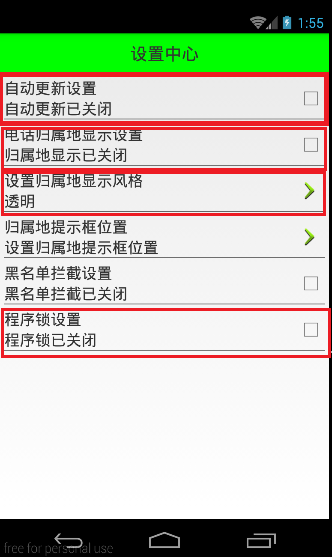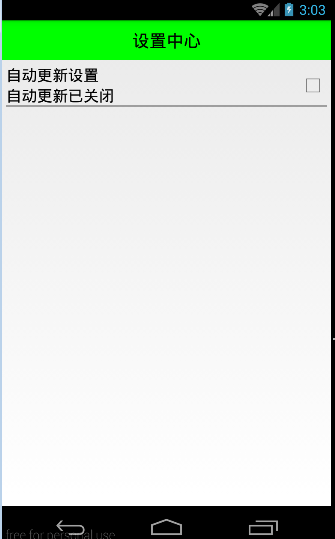Android 手机卫士--自定义组合控件构件布局结构
由于设置中心条目中的布局都很类似,所以可以考虑使用自定义组合控件来简化实现

本文地址:http://www.cnblogs.com/wuyudong/p/5909043.html,转载请注明源地址。
自定义组合控件
1.将已经编写好的布局文件,抽取到一个类中去做管理,下次还需要使用此布局结构的时候,直接使用组合控件对应的对象.
2.将组合控件的布局,抽取到单独的一个xml中
新建布局文件:setting_item_view.xml,将上篇文章中布局文件中的代码放进去
<?xml version="1.0" encoding="utf-8"?> <RelativeLayout xmlns:android="http://schemas.android.com/apk/res/android" android:layout_width="match_parent" android:layout_height="wrap_content" > <RelativeLayout android:layout_width="match_parent" android:layout_height="wrap_content" android:padding="5dp" > <TextView android:id="@+id/tv_title" android:layout_width="wrap_content" android:layout_height="wrap_content" android:text="自动更新设置" android:textColor="#000" android:textSize="18sp" /> <TextView android:id="@+id/tv_des" android:layout_width="wrap_content" android:layout_height="wrap_content" android:layout_below="@id/tv_title" android:text="自动更新已关闭" android:textColor="#000" android:textSize="18sp" /> <CheckBox android:id="@+id/cb_box" android:layout_width="wrap_content" android:layout_height="wrap_content" android:layout_alignParentRight="true" android:layout_centerVertical="true" /> <View android:layout_width="match_parent" android:layout_height="1dp" android:layout_below="@id/tv_des" android:background="#000" /> </RelativeLayout> </RelativeLayout>
3.通过一个单独的类SettingItemView.java,去加载此段布局文件.
package com.wuyudong.mobilesafe.view; import com.wuyudong.mobilesafe.R; import android.content.Context; import android.util.AttributeSet; import android.view.View; import android.widget.CheckBox; import android.widget.RelativeLayout; import android.widget.TextView; public class SettingItemView extends RelativeLayout { private TextView tv_des; private CheckBox cb_box; public SettingItemView(Context context) { this(context, null); } public SettingItemView(Context context, AttributeSet attrs) { this(context, attrs, 0); } public SettingItemView(Context context, AttributeSet attrs, int defStyle) { super(context, attrs, defStyle); // xml-->view 将设置界面的条目转换成view对象 View.inflate(context, R.layout.setting_item_view, this); // 等同于以下两行代码 /* * View view = View.inflate(context, R.layout.setting_item_view, null); * this.addView(view); */ //自定义组合控件中的标题描述 TextView tv_title = (TextView) findViewById(R.id.tv_title); tv_des = (TextView) findViewById(R.id.tv_des); cb_box = (CheckBox) findViewById(R.id.cb_box); } }
这样只需要简单的几行代码就可以完成布局文件的调用
<?xml version="1.0" encoding="utf-8"?> <LinearLayout xmlns:android="http://schemas.android.com/apk/res/android" android:layout_width="match_parent" android:layout_height="match_parent" android:orientation="vertical" > <TextView style="@style/TitleStyle" android:text="设置中心" /> <!-- <RelativeLayout android:layout_width="match_parent" android:layout_height="wrap_content" android:padding="5dp" > <TextView android:id="@+id/tv_title" android:layout_width="wrap_content" android:layout_height="wrap_content" android:text="自动更新设置" android:textColor="#000" android:textSize="18sp" /> <TextView android:id="@+id/tv_des" android:layout_width="wrap_content" android:layout_height="wrap_content" android:layout_below="@id/tv_title" android:text="自动更新已关闭" android:textColor="#000" android:textSize="18sp" /> <CheckBox android:id="@+id/cb_box" android:layout_alignParentRight="true" android:layout_centerVertical="true" android:layout_width="wrap_content" android:layout_height="wrap_content" /> <View android:layout_below="@id/tv_des" android:background="#000" android:layout_width="match_parent" android:layout_height="1dp" /> </RelativeLayout> --> <com.wuyudong.mobilesafe.view.SettingItemView android:layout_width="match_parent" android:layout_height="wrap_content" > </com.wuyudong.mobilesafe.view.SettingItemView> </LinearLayout>
运行项目后,有如下效果:

作者:wuyudong
本文版权归作者和博客园共有,欢迎转载,但未经作者同意必须保留此段声明,且在文章页面明显位置给出原文连接,否则保留追究法律责任的权利.
如果觉得本文对您有帮助,可以对作者进行小额【赞助】



【推荐】国内首个AI IDE,深度理解中文开发场景,立即下载体验Trae
【推荐】编程新体验,更懂你的AI,立即体验豆包MarsCode编程助手
【推荐】抖音旗下AI助手豆包,你的智能百科全书,全免费不限次数
【推荐】轻量又高性能的 SSH 工具 IShell:AI 加持,快人一步